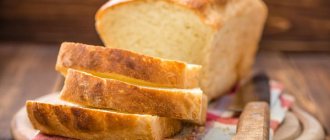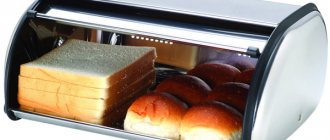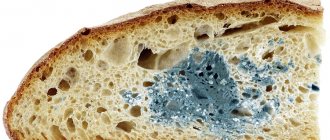The shelf life of baked goods is short. So, how to store bread so that it does not go stale or moldy?
Rye is stored for 36 hours, wheat - for a day. Small items up to 200 grams – 16 hours. To preserve the nutritional and taste properties of baked goods, it is recommended to maintain an air humidity of 75% and a temperature of 18-25 C.
Bread that goes on sale is accompanied by documents indicating the date and hour of baking. During storage, processes occur in flour products that deteriorate the quality and taste. The product loses moisture and dries out.
Why does bread spoil quickly?
Bread is included in the list of perishable products due to its composition. You've probably noticed that a loaf bought in the morning loses its freshness, taste and aroma by the evening. If the bread has been untouched for several days, mold may appear on its surface.
Modern bread is very different from the products that our grandparents ate. Then it simply became stale and dried out, and now even after 2-3 days of storage it becomes moldy. This phenomenon can occur due to various reasons:
- a large number of impurities and emulsifiers have been added to the composition;
- stale raw materials were used;
- production technology is disrupted;
- storage and transportation standards are not met;
- non-compliance with safety regulations at work.
To always buy fresh rolls and loaves, pay attention to several characteristics:
- Crust condition. It should be smooth without burnt areas.
- Crumb density. It shouldn't crumble.
- Aroma. Its absence or change indicates that the product has been sitting for a long time.
It is best to buy bread from a trusted seller, who will tell you how long the loaves, if they are unpackaged, have been lying on the counter.
How to determine freshness when purchasing?
When buying bread in a store, look beyond the label. Be sure to carefully study the product itself. If it smells bad, sour or musty, it's already spoiled. Cracks, burnt areas - all this indicates low quality of the product. It is better not to take such bread.
Freshness in appearance:
- The crust should be glossy, even shiny, uniform, without burns or cracks.
- Baking without voids and uniform. The crumb should not crumble.
- The smell should be pleasant.
To replace the bread with a quality one or get a refund, you definitely need a receipt. Witnesses and surveillance cameras are useless. If the store refuses, you should contact Rospotrebnadzor. The examination they conduct will help prove the store’s guilt.
If it is confirmed that the product is spoiled, a fine will be imposed on the store. It is important to check the bread when purchasing so as not to be accused of forgery.
Bread may also be sold with an indication that it is expired. If you buy it, the store will not accept it back.
What material to use for storing bread
The product will stay fresh longer if you choose the right storage container. Natural fabric or paper copes well with this function. Plastic, polyethylene or foil also preserve the freshness of bread well. However, when using them, take care of ventilation inside, since condensation appears on the inner surface of such materials.
In paper
In supermarkets, baked goods are often sold in special paper bags in the bakery departments. They are suitable for storing loaves, protect from dust, dirt, allow the bread to “breathe”, but do not protect against drying out. For 1-2 days of storage, this method will do; for a longer period, other options should be considered.
At what temperature should you store bread?
The optimal temperature for storing bread is 20–25 degrees. In this temperature range, the product retains its best consumer characteristics. Like many other products, baked goods do not tolerate sudden temperature changes. Make sure that the room where the bread is located is well ventilated, dry and clean, and the relative air humidity does not exceed 75%.
The procedure for cleaning the “grain place”
The bread shelf and bread bin are washed regularly and dried thoroughly.
Moisture is the enemy of any bread, rye or wheat, unleavened or rich.
Both in containers and in cabinets it is necessary to carry out regular antiseptic treatment with neutral agents - detergents without fragrances, laundry soap, baking soda, vinegar.
How to store freshly baked bread
If you are pampering your family with fresh baked goods, prepared yourself, take into account the following rules:
- Try to remove the product from the mold as quickly as possible, otherwise the crust will not be crispy.
- Do not pack hot bread until it has cooled completely.
- For storage containers, use a plastic or paper bag, a towel made of natural fabric, or simply put the baked goods in a bread bin.
How to revive bread that is going stale: 10 ideas for stale bread
Staleness is not yet a reason to throw away bread. If it has not had time to dry completely, you can try to return the structure to its normal softness. Any moldy piece will have to be thrown away.
How to revive bread:
- moisten in water, place in a bag, container or mold with a lid. Place in the oven or microwave for a few minutes. The amount of water depends on the callousness. For something that has been in the refrigerator for a couple of days, spraying the crust will suffice;
- steam the pieces for a couple of minutes in a colander in a bathhouse. Serve or seal tightly, otherwise the moisture will evaporate quickly.
Rusks are suitable for preparing some dishes and drinks. 10 ideas for stale or dried out bread:
- Rusk bowl
The suharnitsa was baked in Russian ovens. Beat 3 eggs and 3 tbsp. milk. Grease a baking dish with oil, where 100 g of rye or wheat crackers are placed. Pour in the egg-milk mixture and after standing for half an hour, bake for half an hour in a well-heated oven.
- Breading
Crushed wheat crackers are used as a breading coating for cutlets and chops. It is important that they are made from bread without seeds, fruits or other additives. Stale bread is grated and stored in the freezer or dried in the oven.
- With dumplings
White bread crackers are an excellent addition to dumplings with cottage cheese. For this purpose, the bread is finely chopped or grated on a coarse grater and dried. Add to the finished dish, pouring over melted butter.
- Kvass
Kvass on rye crackers is prepared for okroshka or drinking, to which raisins and additional sugar are added. Stale rye bread should be cut into pieces about 1 cm in size and dried until dark at 180°C.
200 g of crackers, pour 3 liters of boiling water, add 3 tbsp. sugar, stir and wait for it to cool to room temperature. 20 g of fresh yeast are diluted in a glass of warm rusk water and left until the foam cap rises. Mix with the rest of the solution, cover with a cloth and place in a warm place for 2 days. Strain the kvass into a jar. For drinking, add 5-6 raisins and leave for another day.
- Cake for tea
Slice bread or dried loaf. Place the pieces in pairs, sandwiching them with any jam. Spread butter on top and cut into strips. Oil is dipped in sugar and placed on a sheet. Bake at 200°C for 10 minutes.
- Toast
Dried pieces of bread are dipped in eggs beaten with milk and fried on both sides. A mixture of 1 egg and a glass of milk is made sweet (sugar, honey to taste) or spicy (salt, garlic, pepper).
- Chicken salad
Cut into pieces 300 g of boiled chicken fillet, 200 g of hard cheese, 300 g of canned corn, 200 g of crackers. Season with 200 g of mayonnaise and mix. Leave in the refrigerator for a couple of hours to soak the crackers, then serve.
- Dessert with fruits
Rusks are laid out in layers in a deep form, alternating with flat-cut apples or other fruits. Fill each layer of crackers with a beaten mixture of eggs and sugar. To make the cake more tender, leave it on the table for 40 minutes before putting it in the oven.
- Pancakes
Mix 2 cups of grated crackers and a glass of milk, leave to swell. Add 2 eggs, finely chopped onion. Fry in oil like pancakes. Serve as a separate dish with sour cream and as a side dish for meat.
- Rum cake
Fry 2 tablespoons of flour in 2 tablespoons of butter until golden brown. Pour in 1.5 cups of milk, add 2 tablespoons of sugar and heat until it thickens. Mix the mass with 500 g of grated crackers (preferably from butter rolls), a spoonful of rum or cognac, add a spoonful of instant coffee, nuts, and candied fruits if desired.
Form a rope and cut into pieces. Keep in a cold place for an hour and cover with chocolate glaze.
Where is the best place to store bread at home?
Most importantly, do not leave the finished loaf outdoors, especially in direct sunlight. To keep the product fresh for as long as possible, use various storage devices.
Foil or plastic bag
Polyethylene or foil do a good job of preserving the freshness of bread, but only with proper storage. Basic rules for storing bread in a bag or foil:
- Use only a new bag or piece of foil to avoid mold.
- Close the package tightly to prevent the bun from drying out.
- At the same time, do not allow moisture to collect inside. To do this, make several small holes in the packaging.
In the original polyethylene packaging, the bread will last for at least 3 days, provided that you close the bag tightly.
Paper, textile or clay
This storage method came to us from our grandmothers. In the old days, it was customary to wrap bread in a piece of natural fabric. This way it could stay fresh for at least 2 days. The method is still popular among many housewives. Use kitchen towels made from natural materials without a pattern or a special fabric bag for bakery products for storage. The bags consist of 3 layers: the outer and inner are breathable materials, the middle is perforated polyethylene. You can buy similar devices in the hardware department of the supermarket.
An excellent place for storage would be paper bags, which are often sold in stores. The material prevents the product from drying out, breathes well, and does not allow moisture to pass through. In a closed paper bag, the loaf will remain fresh for up to 3 days.
An alternative to a bread box is a simple clay pot. The material will help keep the product fresh for 5–7 days. To achieve these results, simply cover a fresh loaf with a clay pot.
Vacuum
In vacuum packaging, bread can last from 7 to 10 days. After this time, the product will remain as soft and fresh as it was before storage.
Breadbox
A classic option for storing bread. In addition to its main function, the bread box also acts as an element of kitchen decor. In the range of products for storing food you will find products made of metal, wood, plastic or clay. Each material has different performance characteristics.
The loaf can stay fresh for up to one week if you first wrap it in a linen towel and make sure the lid of the bread bin is always closed
Secrets of long-term storage
– Bread will be tasty and healthy for a long time if you follow these tips:
– Place peeled potatoes or apple slices in a container. These products absorb excess moisture and prevent the loaves from hardening.
– A hot, freshly baked loaf should be cooled. Leave for 3 hours, pack.
– Store the rolls in closed containers and pans in additional packaging.
– The old method recommends: first divide the loaf into two parts. Cut the required number of pieces from the center. Remove the rest by pressing with the cuts.
– Keep the product in bags containing 3 layers: fabric inside and outside, plastic between them. the product will remain soft for 3-4 days.
– Cut and sew the bags. Soak in saline solution. Dry without rinsing with water.
To choose the right storage method, try them all and settle on the one that suits you.
Can bread be stored in the refrigerator?
Some housewives keep bread in the refrigerator and claim that it stays fresh for 5-7 days. On the one hand, the refrigerator helps to avoid the appearance of mold, since the temperature from 0 to 2 degrees prevents its occurrence. On the other hand, such a temperature lowers the level of moisture in products, so the bread goes stale much faster.
If you decide to keep the loaf in the refrigerator, don't neglect packaging it. Wrap the loaf in paper or cloth. When using plastic bags or foil, make sure there are holes in the surface for ventilation.
Is it harmful to store bread in the refrigerator?
Of course, it’s up to you to keep the bread in the refrigerator or just in the room. However, please note that this storage option may cause problems:
- the bread will absorb the smells of other products lying on the shelf of the refrigerator next door;
- other foods will absorb the smell of yeast;
- if you place a loaf in polyethylene without holes, it will definitely become moldy;
- When a hot product is placed in the refrigerator, the compressor may become unusable due to the steam released by the bread.
How long can bread be stored in the freezer?
An interesting fact is that the rate of starch crystallization is significantly reduced at temperatures from -10 degrees. Based on this information, we can assume that the bread can last in the freezer for a long time. And indeed it is.
To keep the product for a long time at a temperature of -13 to -18 degrees:
- Place only fresh bread at room temperature into the chamber;
- be sure to pack the product in a bag or foil;
- do not refreeze the rolls;
- For convenience, mark the freezing date directly on the packaging or package the product in portions.
If these conditions are met, the bread will last in the freezer for 2 to 16 weeks.
Keep the frozen product at room temperature for several hours or use an oven, microwave or bread maker to defrost.
What kind of bread is not stored in the refrigerator?
If you are satisfied with the option of storing bread in the refrigerator, please note that it is unacceptable to keep certain types of products on the refrigerator shelf. Namely:
- hot baked goods, which will only harm the refrigerator compressor;
- already spoiled bread with mold appearing on the crust;
- bakery products without packaging.
Otherwise, for this storage option, you can choose any type and variety of products.
What does the duration depend on?
There are several factors that determine the shelf life of bread:
- Package. To extend the shelf life, the manufacturer wraps the product in paper, polyethylene, or film.
This helps for a while and the bread does not go stale longer. In addition, it guarantees the customer cleanliness when storing on store shelves. But even with all this, acceptable storage is no more than a week, but usually 3 days. Once the best before date has passed, even ideal conditions will not help the bread remain edible. - Compound. The effect of extending shelf life is provided by preservatives and thickeners, leavening agents, and acidity regulators - up to several months.
Emulsifiers, for example, will make bread more porous and slow down staling. The bread does not mold, but it is not natural and has no health benefits. Therefore, it is still better not to buy a product with an expiration date that is too long (more than 2 weeks). If it was baked 2 days ago, look for something fresher. After all, you do not know the conditions of conservation before you. If the label is missing, you can get the necessary information from the seller, although there is a risk of being deceived. Dryness of bread begins within 10 hours after baking. The yeast-free version lasts longer. Filled buns spoil the fastest. - Type of flour. Coarse flour is unattractive to mold and this bread stays fresh longer. Therefore, by mixing wheat and rye flour, adding sugar and fat, the manufacturer increases the shelf life of bread. Additives retain moisture in the product. The staling process slows down noticeably. However, not every combination of flour helps: barley and corn, on the contrary, will shorten the shelf life.
- Living conditions that do not meet the standard standards significantly reduce the shelf life of bread. Mold loves moisture and warmth. The temperature should not exceed 22°C.
- Production technology. This refers to violations of the sourdough conditioning, Sanitary Regulations, and baking temperature. Bread with high-speed kneading and a long fermentation period is stored longer.
Which bread box is best to store bread in?
You can understand which bread box is better by analyzing the characteristics of products made from various materials.
Bread bins:
- made of wood have the highest hypoallergenic and antiseptic properties, but require the most careful care and can become damp;
- made of plastic - cheap and practical, but quickly deteriorate;
- made of clay or glass perform well, but are too fragile;
- made from metal has the best heat and aroma retention properties, are durable and easy to care for, but are slightly more expensive than analogs made from other materials.
When choosing a product, think about what characteristics come first for you, and make a choice based on your preferences. When purchasing, make sure that the lid closes tightly and that there are as few ventilation holes on the body as possible.
If you usually buy several types of bread at once, give preference to bread bins with several sections. Otherwise, keep products with different compositions by packing each in a separate bag.
Traditional option - bread box
Most housewives prefer a bread box. It justifies its purpose both in a small kitchen and in a spacious kitchen-living room. Which bread bin is best to choose based on design and material of manufacture is a matter of individual preference.
Material selection:
- made of plastic - as a neutral composition, it retains moisture and protects against foreign odors. These same qualities contribute to the appearance of mold and air stagnation. Treatment with acetic acid for prevention is recommended once a week;
- made of wood is the best bread box in terms of shelf life. If the wood has not been treated with impregnations or varnish, it does not produce foreign odors, but, on the contrary, accumulates them. To clean the top layer and disinfect it, treat it with boiling water once a month. Naturally, dry cleaning is carried out as needed;
- made of birch bark - an original type of bread bin, retains all the advantages of wood;
- made of ceramics - dishes made of neutral material best preserve the taste and aroma of any product. A ceramic pot or vase will keep the loaf fresh for several days. Unglazed ones are difficult to keep clean; glazed ones are not suitable for long-term storage, as they do not allow air to pass through;
- made of stainless steel - for those who prefer simplicity and conciseness, as well as for clean people. Metal can simply be wiped with a clean cloth. It doesn’t hurt to cover the bottom with a clean cotton or linen cloth and place a wooden board to preserve the taste of the bread;
- made of glass - bread bins protect against staleness and look stylish; in a small kitchen they do not burden the space. They are absolutely sealed, so it is necessary to prevent the development of fungus;
- made of wicker - in such a container the bread will remain soft for a maximum of a couple of days. Crumbs get stuck in the cracks. To keep the utensils clean, cover them with a napkin, wash them with warm water and treat them with boiling water or vinegar.
How to store so that bread does not go moldy
To prevent mold from appearing on the crust for as long as possible:
- Place a handful of salt or an apple slice in the place where you store your baked goods. As soon as the apple begins to rot, replace the old slice with a new one;
- Keep the bread bin clean - wash the inside surface weekly with water and vinegar and do not allow moisture to remain inside;
- remove crumbs from the bread bin in a timely manner;
- a product prepared with vegetable rather than animal fats is less susceptible to fungus;
- Always keep the bread bin closed.
To prevent baked goods from becoming stale, cut the loaf not from the edge, but from the middle. After cutting the required number of slices, fold the halves crumbwise towards each other and pack.
Kinds
The smaller the area, the more important it is to organize your workspace correctly. We have to decide how to save space in the kitchen. Modern bread bins look good on the dining table, but sometimes they just get in the way.
To stop worrying about where to put the bread bin, you can practically arrange storage built into the kitchen. This could be a regular shelf with a door in the top tier of the unit, where packaged rolls are placed or boxes of sliced meats are placed.
A simple solution is an open shelf for installing a compact bread bin.
In lower cabinets it is convenient to use a drawer for this purpose. Be sure to make a metal, wooden or plastic lid.
The bread bin in the kitchen interior can be hanging. Choose roof rails, regular screws or hooks.
One of the options for saving kitchen space is corner placement. Carefully choose a section of the wall away from the stove and sink.
An old bread box will turn into an exclusive interior detail if you choose a creative idea. You can simply prime and paint, use decoupage on metal, burning and painting on wood.
Black and white together or separately?
This question applies not only to black or white bread, but to all its varieties in general. Due to differences in composition, products are influenced by the external environment at different times and under the influence of different factors. For example, one type of bread will spoil in a day, while another may last for 2-3 days. If the loaves are nearby, the bacteria from the spoiled product will transfer to the high-quality product, and it will also become unusable. To prevent this from happening, keep each variety separately, in different bags or in several sections of the bread bin.
Is it possible to keep different varieties together?
Each person prefers his own type of bread. This is not a whim, but a requirement of the body. Technologists do not recommend mixing together white and black bread, rye and wheat, freshly baked homemade bread with stale bread in storage containers. It is better to place them in individual containers, bags, boxes.
Why you can’t store different types in one place:
- The composition of the microbiological environment depends on the starter or yeast used in baking. Joint storage can cause musty, unpleasant acidic odor in wheat buns;
- The percentage of moisture in some varieties is higher, in others it is lower. In one bread box, the moisture will be evenly distributed throughout the entire volume. For example, dry bread next to a bun will become moist and soft;
- white bread is more susceptible to foreign odors. Its aroma will be lost against the background of rye.
How to store different types of bread
The components that make up different types of bread have different properties. This means that one type of baked goods can stay fresh for a long time, while another cannot.
Wholegrain
In the production of whole grain bread, sprouted wheat seeds are used, thanks to which the product is considered very healthy. When choosing such baked goods, pay attention to the ingredients on the packaging. The first component should be whole grain flour.
Also, the composition should contain a minimum of impurities and preservatives.
Real whole grain bread will stay fresh for 48 hours and 72 hours when packaged. Optimal storage conditions are a dry, ventilated room with a temperature of 20–25 degrees and a relative humidity of 75%.
Yeast-free
Despite the fact that bread is prepared without the use of yeast, it, like other varieties, can become stale. Typically, yeast-free bread can be stored for 7–10 days.
These terms are arbitrary and depend on the type and technology of baking. Storage conditions also affect the safety of the product. It is best to keep the loaf in plastic, paper, foil or cloth and put it in a bread bin or cupboard.
Gluten-free
Gluten-free varieties differ from classic ones in that they contain types of flour that do not contain gluten. Such products are usually consumed by people who are intolerant to the substance or who want to eat more healthily.
The best place to store gluten-free bread is in the freezer. Once prepared or purchased, cut the loaf into pieces, portion and freeze. Before use, heat the required number of servings in the microwave.
Otrubnoy
Products with bran differ from classic ones in that they contain bran in addition to flour. If you provide the bread with the proper conditions, keep it in cellophane, paper or a bread box, it will last 5-7 days without spoiling.
Bread crackers
Such a product can remain in its proper form from several months to two years, but only if the required level of humidity is maintained in the room (no more than 75%).
Storage nuances:
- It is better to keep crackers in a dark and cool place;
- At the first sign of spoilage, immediately discard the product;
- do not place crackers near the bread, otherwise both products will become unusable faster;
- be sure to keep the crackers in the packaging: plastic or paper bag, fabric bag, foil;
- Rusks that are dried rather than fried (especially with the addition of oil) last longer;
- if the composition contains additional ingredients, the shelf life is reduced;
- Use snack crackers immediately after opening the package.
Is it possible to eat expired product?
Expired bread can be of two types:
- Moldy ones go only for disposal. Mold spores are not killed by heat, drying, or frost. Maturing mold produces substances that are toxic to humans. In addition, additives in the form of preservatives and flavorings are also harmful, and if expired, they are doubly dangerous.
- Dried can be partially restored and consumed within a short time.
You should not stock up on bread if there is no feast coming up. This is not a scarce product, and fresh is much tastier than stale, even for a day. However, you can extend the shelf life with the right approach.
If you find an error, please select a piece of text and press Ctrl+Enter.
Shelf life and storage of bakery products according to GOST
First of all, it is worth noting that the state standard for storing bread is established within the framework that is calculated for the sale of the product. This means that the actual shelf life of bakery products is slightly higher than the prescribed values. There are 2 types of GOST standards, which depend on the type of product, the method of its preparation and the presence of packaging.
- For products that can be stored for no more than 2 days. The packaging must contain not only the date, but also the time of packaging.
- For products that can be stored for more than 48 hours. The label will be marked with the date of packaging.
Storage standards for main types of bakery products:
- cut: in packaging – 72 hours, without packaging – 24 hours;
- white of the first category: in packaging 72 hours, without packaging – 24 hours;
- small loaves up to 200 g – no more than 16 hours;
- Borodinsky - 36 hours;
- crackers – 60 days.
In fabric
It is believed that this method is environmentally friendly and simple. The loaf is wrapped in a large linen napkin or towel and placed in a bread bin or any other container.
Instead of towels, fabric bags are suitable. The fabric must be natural, without mixed additives or synthetics. In this material, baked goods will remain fresh for up to 4-5 days.
How to preserve bread while traveling
If you are going on a hike or a picnic, take care of food. Typically, a tourist's food package also includes baked goods. To keep them fresh as long as possible:
- When choosing, give preference to varieties that have a maximum shelf life.
- Keep the products only in the packaging and do not allow moisture to get into it.
- Cut the loaf not from the edge, but from the middle. After cutting off the required amount, fold the halves and pack them in a bag. This way the bun will last longer.
A good idea would be to vacuum-pack the bread. Portion the product and pack it. Open one serving package before eating.
Bread will last longer if the necessary storage conditions are observed. The main thing is not to let the product come into contact with air or sun rays. Of course, it is better to buy baked goods for future use, but if this is not possible, use simple tips and tricks to help extend the shelf life.
How to restore freshness to a dried product?
There are several ways to reanimate stale products; they, of course, will not become fresh baked goods, but they will be possible to eat:
- If the bread has just begun to go stale, to restore it you can sprinkle it with water and put it in an oven preheated to 150°C for 5 minutes. You need to eat this bread within 2 hours.
- Cut into slices, place in a colander and keep in a water bath.
We invite you to watch a video on how to restore freshness to dried bread:
Storage in special bags
Reusable special bags equipped with perforated gaskets are becoming popular. Thanks to the special structure of the material, packaged loaves, long loaves and rolls remain fresh for up to 10-12 days.
Due to perforation, excess moisture is absorbed, the crumb does not dry out, the bread crust does not soften, and mold does not form. The bags are sold in sets, and manufacturers produce packaging in different sizes - “long” for baguettes and standard for regular loaves and loaves.











